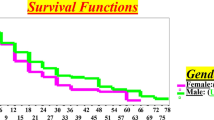Abstract
Changes in immunologic parameters were followed in members of a cohort of human immunodeficiency virus (HIV)-positive homosexual or bisexual men with lymphadenopathy and were analyzed for differences between those who have and those who have not progressed to the acquired immunodeficiency syndrome (AIDS) (progressors, nonprogressors). T helpers and the Th/Ts ratio were lower in progressors than in nonprogressors both at entry into the study and at the latest visit. T suppressors were not different in the two groups at entry but were higher in nonprogressors at the latest visit. Evaluation of the patterns of change over time showed that T helpers and Th/Ts ratios tended to decrease over time in both nonprogressors and progressors, while T suppressors increased in nonprogressors and decreased in progressors. Although progressors had a greater deterioration in immunologic parameters over time, nonprogressors also had significant deterioration when compared with controls. Based on the respective percentages of men with abnormal or normal T helpers or Th/Ts ratio at entry who have already progressed to AIDS, we would conservatively estimate, considering their latest T helpers and Th/Ts ratio, that at least an additional 16 (32%) of our nonprogressors will develop AIDS in the next 5 years.
Similar content being viewed by others
References
Centers for Disease Control: Revision of the CDC surveillance case definition for acquired immunodeficiency syndrome. Morbid Mortal Week Rep 36:1S-15S, 1987
Fishbein DB, Kaplan JE, Spira TJ, Miller B, Schonberger LB, Pinsky PF, Getchell JP, Kalyanaraman VS, Braude JS: Unexplained lymphadenopathy in homosexual men: A longitudinal study. JAMA 254:930–935, 1985
Kaplan JE, Spira TJ, Fishbein DB, Pinsky PF, Schonberger LB: Lymphadenopathy syndrome in homosexual men: Evidence for continuing risk of developing the acquired immunodeficiency syndrome. JAMA 257:335–337, 1987
Nicholson JKA, McDougal JS, Spira TJ, Cross GD, Jones BM, Reinherz EL: Immunoregulatory subsets of the T-helper and T-suppressor cell populations in homosexual men with chronic unexplained lymphadenopathy. J Clin Invest 73:191–201, 1984
Lehmann EL: Nonparametrics: Statistical Methods Based on Ranks. New York, McGraw-Hill, 1975
Snedcor GW, Cochran WG: Statistical Methods. Ames, Iowa State University Press, 1980
El-Sadr W, Marmor M, Zolla-Pazner S, Stahl RE, Lyden M, William D, D'Onofrio S, Weiss S, Saxinger WC: Four-year prospective study of homosexual men: Correlation of immunologic abnormalities, clinical status, and serology to human immunodeficiency virus. J Infect Dis 155:789–793, 1987
Frazer IH, Mackay IR, Crapper RM, Jones B, Gust ID, Sarngadharan MG, Campbell DC, Ungar B: Immunological abnormalities in asymptomatic homosexual men: Correlation with antibody to HTLV-III and sequential changes over two years. Q J Med 61:921–933, 1986
Melbye M, Biggar RJ, Ebbesen P, Neuland C, Goedart JJ, Faber V, Lorenzen IB, Skinhoj P, Gallo RC, Blattner WA: Long-term seropositivity for human T-lymphotropic virus type III in homosexual men without the acquired immunodeficiency syndrome: Development of immunologic and clinical abnormalities. Ann Intern Med 104:496–500, 1986
Schwartz K, Visscher BR, Detels R, Taylor J, Nishanian P, Fahey J: Immunological changes in lymphadenopathy virus positive and negative symptomless male homosexuals: Two years of observation. Lancet 2:831–832, 1985
Weber JN, Rogers LA, Scott K, Berrie E, Harris JRW, Wadsworth J, Moshtael O, McManus T, Jeffries DJ, Pinching AJ: Three-year prospective study of HTLV-III/LAV infection in homosexual men. Lancet 1:1179–1182, 1986
Lane HC, Masur H, Gelmann EP, Longo DL, Steis RG, Chused T, Whalen G, Edgar LC, Fauci AS: Correlation between immunologic function and clinical subpopulations of patients with acquired immune deficiency syndrome. Am J Med 78:417–422, 1985
Nicholson JKA, McDougal JS, Spira TJ: Alterations of functional subsets of T helper and T suppressor cell populations in acquired immunodeficiency syndrome (AIDS) and chronic unexplained lymphadenopathy. J Clin Immunol 5:269–274, 1985
Stites DP, Casavant CH, McHugh TM, Moss AR, Beal SL, Ziegler JL, Saunders AM, Warner NL: Flow cytometric analysis of lymphocyte populations in AIDS using monoclonal antibodies and simultaneous dual immunofluorescence. Clin Immunol Immunopathol 38:161–167, 1986
Walker CM, Moody DJ, Stites DP, Levy JA: CD8+ lymphocytes can control HIV infection in vitro by suppressing virus replication. Science 234:1563–1566, 1986
Plata F, Autran B, Martins LP, Wain-Hobson, S, Raphael M, Mayaud C, Denis M, Guillon JM, Debre P: AIDS virus-specific cytotoxic T lymphocytes in lung disorders. Nature 328:348–351, 1987
Walker BD, Chakrabarti S, Moss B, Paradis TJ, Flynn T, Durno AG, Blumberg RS, Kaplan JC, Hirsch MS, Schooley RT: HIV-specific cytotoxic T lymphocytes in seropositive individuals. Nature 328:345–348, 1987
Kaplan JE, Spira TJ, Fishbein DB, Pinsky PF, Schonberger LB: A 6-year follow-up of HIV infected homosexual men with lymphadenopathy: Evidence for an increasing risk for developing AIDS. JAMA 260:2694–2697, 1988
Gendelman HE, Phelps W, Feigenbaum L, Ostrove JM, Adachi A, Howley PM, Khoury G, Ginsberg H, Martin M: Trans-activation of the human immunodeficiency virus long terminal repeat sequence by DNA viruses. Proc Natl Acad Sci USA 83:9759–9763, 1986
Mosca JD, Bednarik DP, Raj NBK, Rosen CA, Sodroski JG, Haseltine WA, Hayward GS, Pitha PM: Activation of human immunodeficiency virus by herpesvirus infection: Identification of a region within the long terminal repeat that responds to a trans-acting factor encoded by herpes simplex virus 1. Proc Natl Acad Sci USA 84:7408–7412, 1987
Siekevitz M, Josephs SF, Dukovich M, Peffer N, Wong-Staal F, Greene WC: Activation of the HIV-1 LTR by T cell mitogens and the trans-activator protein of HTLV-I. Science 238:1575–1578, 1987
Steel CM, Ludlam CA, Beatson D, Peutherer JF, Cuthbert RJG, Simmonds P, Morrison H, Jones M: HLA haplotype A1 B8 DR3 as a risk factor for HIV-related disease. Lancet 1:1185–1188, 1988
Asjo B, Morfeldt-Manson L, Albert J, Biberfeld G, Karlsson A, Lidman K, Fenyo EM: Replicative capacity of human immunodeficiency virus from patients with varying severity of HIV infection. Lancet 2:660–662, 1986
Author information
Authors and Affiliations
Rights and permissions
About this article
Cite this article
Spira, T.J., Kaplan, J.E., Holman, R.C. et al. Deterioration in immunologic status of human immunodeficiency virus (HIV)-infected homosexual men with lymphadenopathy: Prognostic implications. J Clin Immunol 9, 132–138 (1989). https://doi.org/10.1007/BF00916941
Accepted:
Issue Date:
DOI: https://doi.org/10.1007/BF00916941



